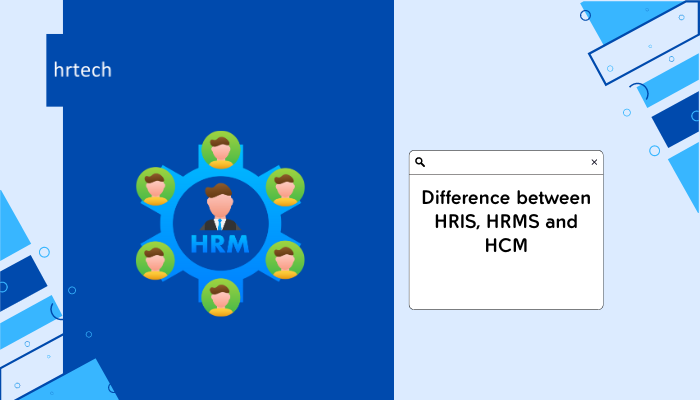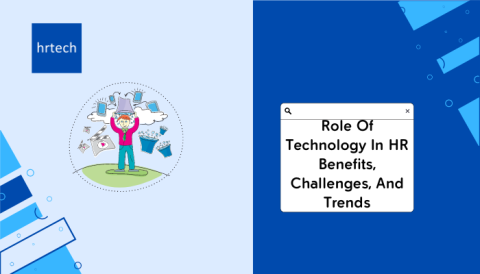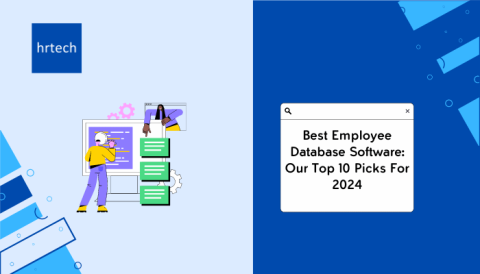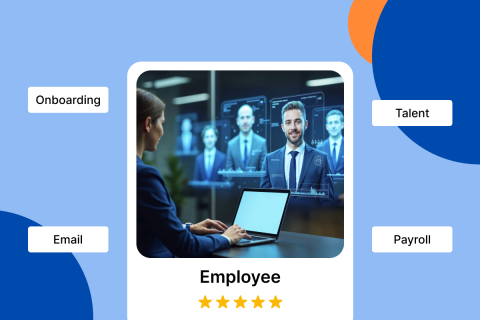HR software has come a long way, giving rise to terms like HRIS, HRMS, and HCM. If you’ve ever felt lost in the HRIS vs. HRMS debate, you’re not alone! These terms often overlap, but each has unique features customized to modern HR needs. So, let’s break them down and see how they’ve evolved over time.
HR departments relied on spreadsheets and paper files for managing employee data. Then came the HRIS, a game changer for centralizing employee information and simplifying payroll. As businesses demanded more, HRMS took the stage, adding benefits management, attendance tracking, and performance reviews. Enter HCM, the most comprehensive of them all, focusing on talent management, employee engagement, and strategic workforce planning.
Today, the choice between HRIS vs. HRMS or even HCMdepends on your business needs. But one thing’s for sure: all three have reshaped how we think about human resource management!
What is an HRIS?
A Human Resource Information System (HRIS) is a comprehensive software solution designed to manage and streamline various HR processes within an organization. By consolidating HR functions into a single platform, an HRIS helps businesses operate more efficiently and effectively.
An HRIS is a digital system that stores, tracks, and manages essential employee information. It provides HR teams with a centralized database to handle various aspects of human resources, reducing manual work and minimizing errors.
Essential Aspects of an HRIS
An HRIS focuses on simplifying HR operations by centralizing employee data, payroll, and benefits management.
| Aspect | Description |
| Primary Goal | To streamline HR processes and centralize employee data management. |
| Core Functions | Employee data management, payroll processing, benefits administration, attendance tracking. |
| Best For | Small to mid-sized businesses looking to manage core HR functions efficiently. |
| Integration Capabilities | Can integrate with other business systems like accounting, payroll, and benefits for seamless data flow. |
| Cost Efficiency | More affordable than HRMS or HCM systems, ideal for businesses with budget constraints. |
Key Features of an HRIS:
The key features of HRIS are below.
- Storage and Tracking of Basic Employee Information: An HRIS serves as a centralized database, storing employee details like personal information, job history, salary, benefits, and performance records. This comprehensive storage makes it easy to access and manage employee data efficiently.
- Recruitment and Talent Relationship Management: The system automates recruitment & onboarding processes, including job postings, applicant tracking, and candidate screening. It also helps maintain relationships with potential hires through talent pools, ensuring a smooth hiring process.
- Automated Onboarding: HRIS software streamlines the onboarding process for new employees. It provides digital checklists, training materials, and orientation resources, making it easier for new hires to get up to speed quickly.
- Performance Management: The system facilitates performance evaluations by collecting feedback from managers, peers, and self-assessments. This feature supports ongoing employee development by tracking goals, achievements, and areas for improvement.
- Employee Self-Service (ESS): ESS empowers employees to access and update their information, such as personal details, benefits, and leave requests, directly through the HRIS. This reduces the administrative burden on HR teams and increases data accuracy.
- Time and Absence Management: An HRIS tracks employee work hours, manages leave requests, and monitors attendance patterns. It provides a clear overview of employee availability, helping managers plan and allocate resources more effectively.
- Training Management: The system supports employee training and development by offering a platform for scheduling courses, tracking progress, and maintaining records of completed training programs.
- Workforce Analysis: By providing detailed reports and analytics, an HRIS enables HR teams to gain insights into workforce trends, performance metrics, and turnover rates. These insights support data-driven decision-making and strategic workforce planning.
An HRIS serves as a central hub for all HR activities, enhancing productivity, improving employee engagement, and supporting overall business growth.
What is an HRMS?
A Human Resource Management System (HRMS) is an advanced software platform that goes beyond the basic functions of an HRIS (Human Resource Information System) to offer a more comprehensive suite of HR management tools. An HRMS not only stores employee data but also integrates various HR processes, providing a holistic approach to human resource management within an organization.
An HRMS is a digital solution designed to manage a wide range of HR activities, including employee benefits, payroll, compliance, performance, learning and development, and more. It serves as an all-in-one platform that supports HR departments in handling complex workforce management tasks efficiently.
Essential Aspects of an HRMS
An HRMS goes beyond basic HR functions, offering a comprehensive suite that includes time tracking, performance management, and analytics. It provides a more holistic view of workforce data, empowering businesses to automate complex HR tasks and make data-driven decisions.
| Aspect | Description |
| Primary Goal | To automate a wider range of HR processes, including recruitment, performance management, and analytics. |
| Core Functions | All HRIS functions plus recruitment, onboarding, performance management, benefits tracking, and analytics. |
| Best For | Medium to large businesses needing comprehensive HR management and integrated analytics. |
| Integration Capabilities | Integrates with broader business tools, including financial, performance, and analytics software. |
| Cost Efficiency | Moderately priced, offering a balance between cost and functionality for mid-sized to large businesses. |
3. Key Features of an HRMS:
The key features of HRMS are below.
- Employee Benefits Administration: The HRMS simplifies the management of employee benefits, including health insurance, retirement plans, and other perks. Employees can enroll and manage their benefits through a self-service portal, while HR teams can track enrollments, eligibility, and compliance with regulations.
- Time, Labor, and Payroll Management: An HRMS automates payroll processing, time tracking, and labor management. It accurately calculates salaries, deductions, and overtime while ensuring compliance with labor laws. This streamlines payroll operations and reduces errors, freeing up HR staff for more strategic tasks.
- Real-Time Reporting and Financial Analysis: HRMS software offers advanced analytics and real-time reporting tools, providing insights into key metrics like employee performance, payroll expenses, turnover rates, and more. This feature helps HR managers and business leaders make informed, data-driven decisions.
- Compliance Features: Keeping up with changing labor laws and regulations can be challenging. An HRMS includes compliance tools that automatically update to reflect the latest legal requirements. It generates compliance reports, tracks audit trails, and ensures that the company adheres to local, state, and federal labor laws.
- Learning and Development Management: This feature facilitates employee training and development by offering tools for creating, assigning, and tracking training programs. Employees can access online courses and resources through the HRMS, and managers can monitor progress to ensure skills development aligns with organizational goals.
- Customizable to Organizational Needs: An HRMS is designed to be flexible and adaptable. It allows businesses to customize workflows, forms, and modules to fit their specific HR processes and organizational structure. This customization ensures that the HRMS meets the unique needs of the company as it grows and evolves.
- Paperless Onboarding and Probation Management: The HRMS automates the onboarding process, providing digital checklists, forms, and training resources for new hires. It also tracks employees’ progress during their probation period, offering managers the tools to monitor performance and make informed decisions about permanent employment. This paperless approach not only speeds up onboarding but also enhances the overall employee experience.
An HRMS is an essential tool for modern HR departments, offering a comprehensive solution that covers a wide range of HR functions, from hiring to performance management, and beyond.
What is HCM?
Human Capital Management (HCM) is a comprehensive set of practices and tools used to manage, develop, and optimize an organization’s workforce. It goes beyond traditional HR functions, focusing on maximizing employee potential and aligning human resources with the strategic goals of the business.
HCM systems are known for their advanced functionalities, integrating various HR processes into a unified platform. They provide strategic insights through data analytics, support succession planning, and help foster a strong organizational culture, going beyond basic HR operations to create a more engaged and skilled workforce.
Essential Aspects of an HRMS
HCM takes HR to a strategic level, focusing on employee development, talent management, and workforce planning. Its employee-centric approach helps companies nurture talent, improve engagement, and align HR processes with long-term business goals.
| Aspect | Description |
| Primary Goal | To strategically manage and develop the workforce, focusing on employee growth, talent management, and engagement. |
| Core Functions | All HRMS functions plus strategic workforce planning, talent management, employee engagement, and succession planning. |
| Best For | Enterprises aiming for a strategic, employee-centric HR approach with a focus on talent and long-term planning. |
| Integration Capabilities | Seamless integration with various business systems, focusing on talent analytics, workforce planning, and training programs. |
| Cost Efficiency | Higher cost due to advanced features, strategic planning tools, and robust analytics, suited for large enterprises. |
Key Features of HCM:
The key features of HCM are below.
- Performance Management, Learning, and Succession Planning: HCM focuses on developing employee skills and career paths. It includes tools for performance reviews, goal-setting, and ongoing learning. Succession planning features help identify high-potential employees and prepare them for future leadership roles, ensuring the organization has a strong talent pipeline.
- Compensation Planning: HCM systems support strategic compensation planning by allowing organizations to manage salary structures, bonuses, and other incentives. This helps in retaining top talent and ensures that compensation aligns with company goals and market standards.
- Strategic Workforce Planning and Workforce Modeling: HCM provides advanced tools for workforce planning, helping organizations forecast staffing needs and create models for different workforce scenarios. It allows companies to identify skill gaps, optimize headcount, and align talent with business objectives.
- Talent Acquisition (Applicant Tracking System – ATS): HCM integrates sophisticated ATS functionalities to streamline recruitment. It manages the entire hiring process, from job postings to candidate screening, interviews, and offers, ensuring that the company attracts and selects the best talent efficiently.
- Culture-Building and Competency Mapping: A strong company culture and clear competency frameworks are critical to employee engagement and performance. HCM systems help build and reinforce organizational culture by promoting company values, tracking employee competencies, and mapping out development paths that align with both individual and business goals.
HCM is a strategic approach to managing human resources, emphasizing the development and optimization of an organization’s most valuable asset—its people. By focusing on data-driven decision-making and employee growth, HCM systems contribute to building a more agile, productive, and engaged workforce.
Comparing HR Systems: HRIS vs. HRMS vs. HCM
When it comes to HR software, the terms HRIS, HRMS, and HCM are often used interchangeably, but they each have distinct capabilities.
| Feature | HRIS | HRMS | HCM |
| Core Focus | Basic HR Operations | Comprehensive HR Management | Strategic HR and Employee Development |
| Data Management | Yes | Yes | Yes |
| Payroll Management | Yes | Yes | Yes |
| Benefits Administration | Limited | Yes | Yes |
| Time and Attendance Tracking | No | Yes | Yes |
| Recruitment and Onboarding | No | Basic | Advanced |
| Performance Management | No | Yes | Yes |
| Analytics and Reporting | Limited | Integrated | Advanced |
| Talent Management | No | Partial | Yes |
| Employee Engagement | No | Some | Yes |
| Strategic Workforce Planning | No | Limited | Yes |
| Historic Uniqueness | Originally focused on administrative HR tasks. | Developed to expand HR functionalities beyond HRIS. | Emerged as the most strategic approach to managing human capital. |
| Current Overlaps | Limited functionality overlap with HRMS and HCM. | Increasing overlap with HCM as analytics and strategic functions are added. | Comprehensive overlap; includes functionalities of both HRIS and HRMS. |
Each system has its own benefits
It is important to note that each system has its own advantages.
1. HRIS Benefits
- Efficiency in Data Management: HRIS streamlines employee data management, making it easier to store, access, and update information quickly. This leads to more efficient HR decision-making and compliance.
- Improved Productivity: By automating basic HR tasks like payroll and attendance tracking, HRIS creates more cohesive workflows, freeing up HR teams to focus on strategic activities.
2. HRMS Benefits
- Enhanced Data Management and Automation: HRMS expands on HRIS functionalities by automating complex HR tasks like benefits administration, time tracking, and performance reviews. This leads to more accurate data management practices.
- Better Decision-Making: Integrated analytics in HRMS provide deeper insights into workforce performance, helping HR managers make more informed decisions about recruitment, promotions, and overall HR strategies.
3. HCM Benefits
- Data-Driven Decision-Making: HCM takes analytics to the next level, offering tools for strategic workforce planning and talent management. This allows businesses to optimize employee roles and forecast future HR needs effectively.
- Boosted Employee Satisfaction: By focusing on employee-centric processes like career development, training, and engagement, HCM systems improve job satisfaction and retention rates, benefiting both employees and the organization.
Data Safety and Security Considerations
When dealing with sensitive employee information, data security in HR systems are paramount. A breach can lead to financial losses, compliance issues, and a breach of trust with employees.
| Aspect | Description |
| Importance of Data Security | Protects sensitive employee information, ensures compliance, and maintains trust. |
| Segmentation | Divides data into categories to limit access and reduce exposure in case of a breach. |
| Multi-Factor Authentication | Adds extra layers of security to prevent unauthorized access, reducing risks. |
| Password Security | Enforces strong, unique passwords with regular updates to avoid simple attacks. |
| Cloud-Based Security | Built-in security features managed by the provider; relies on internet and provider compliance. |
| On-Premises Security | Gives direct control over security; requires self-management and regular updates. |
Conclusion
The right HR software can be a game-changer for your business. Whether you’re weighing the pros and cons in the HRIS vs. HRMS debate or looking for a full-fledged HCM solution, making an informed choice will shape the success of your HR strategy. The right system streamlines processes, enhances decision-making, and boosts employee satisfaction.
hrtech, is here to help you find the perfect fit, offering solutions customized to your unique needs.
Your ideal HR solution is just a conversation away. Contact us today and let’s shape the future of your HR management together!”





